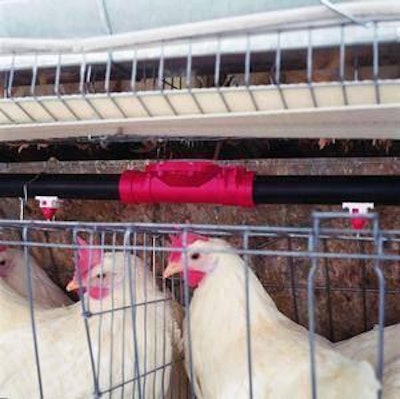
Among the many factors that contribute to the success or failure of a commercial layer operation is the watering system. Often overlooked, it is important both in terms of how it functions and the product it delivers.
Water Supply: Enough But Not Too Much
One of the biggest challenges in a deep pit commercial layer operation is keeping the manure dry. Wet manure results in a variety of unwanted situations, not the least of which is ammonia release. Ammonia can damage the birds' respiratory systems, making them more susceptible to disease. Wet manure also attracts flies and rodents, which can spread disease.
Some of the causes of wet litter include leaking drinkers, drinkers that discharge too much water when triggered by the birds, inadequate air movement over the manure, and fecal material that has an unusually high moisture content.
While a watering system that is providing too much water causes problems with wet litter, a system that is not providing enough water will hurt egg size and production. Going a day without water will cause a hen to stop laying.
Select the Right System
To cope with this quandary, you need to closely examine your watering system. If any of the drinkers are leaking, they should be replaced. But also look at the entire system. Ideally, layer operations need two different watering systems. Chicks from day-old to about 20 weeks need a start-grow watering system where the drinker height and water pressure settings can be easily adjusted to accommodate their growth. Mature birds need a cage watering system that will provide sufficient water but not more than they can drink.
We recommend choosing systems that are developed specifically for layers and not ones that are merely adaptations from broiler applications.
Even with a watering system designed specifically for layer applications, you must guard against conditions that can block or limit the flow of water through the pipes. The three most common causes of these blockages are air locks, sediment build-up and biofilm.
Keep Air Out
Air locks form when water in the pipes releases air as the water warms or as water pressure decreases. If the air pocket or lock becomes sufficiently large, it can restrict the amount of water that flows to the rest of the line. This results in the birds drinking the line dry, creating more air in the lines.
One solution is to ensure the watering line is level. A level watering system does not allow the air to accumulate at high points. In other words, the air is evenly dispersed throughout the watering line and does not pose a problem. If it is impossible to rid the watering lines of high points, installing an air release tube at each high point is of great benefit.
Stop Sediment Build-Up
For poultry operations that rely on well water, suspended particles in the watering lines can become particularly bothersome. These particles can end up in the drinkers, clogging them and/or causing them to leak.
Installing a filter where the water line enters the house (a 5-micron to 10-micron cartridge) will combat sediment, filtering out suspended particles. The filter should be checked and changed frequently to ensure effective operation.
Battle Biofilm by High-Pressure Flushing
Biofilm occurs when bacteria attach to the pipe walls in a drinking system, creating a sticky substrate. As producers introduce interventions of medications and vitamins, bacteria find an ideal breeding ground in glucose and other nutrient-enriched bases used for the veterinary interventions. Additionally, most enclosed watering systems operate at low pressure, providing little turbulence to dislodge this build-up. With biofilm present, the water becomes contaminated with pathogens. Biofilm also can clog drinkers, causing them to provide insufficient water.
Producers commonly introduce chlorine or other sanitising agents into the system to kill bacteria. This practice aids in achieving hygienic water but it does not kill bacteria embedded in biofilm. Nor does it break up the biofilm. The bacterial load in the water quickly returns to the pre-sanitised level.
A good strategy to combat biofilm, as well as air locks and sediment, is to develop a regular schedule for flushing the watering system. Enclosed watering systems make a regular flushing schedule easy with the by-pass valves on flush-through water regulators. We recommend flushing once a day, and more frequently during hot weather.
Warm weather encourages micro-organisms to colonise the system and reproduce quickly. High-pressure flushing not only prevents biofilm from forming but also flushes out tepid water, replacing it with cooler water that is less hospitable to micro-organism growth.
Employing a high-pressure flush using 1.5-3.0 bars (20-40 pounds/in2; psi) pressure is recommended. That is usually sufficient pressure to break up the biofilm. Hydrogen peroxide-based cleaners also have proved to be highly effective in eliminating biofilm. An oxidising agent in hydrogen peroxide scrubs the interior of the pipe clean of biofilm, making the system ready for flushing.
After flushing, the biofilm, sediment and air locks are removed and the risk of clogged, leaky drinkers is greatly diminished.
By paying close attention to the watering system, producers can better manage manure pits and maintain dry conditions. This can go a long way to improving the performance of a commercial layer operation.


.jpg?auto=format%2Ccompress&fit=crop&h=167&q=70&w=250)
.jpg?auto=format%2Ccompress&fit=crop&h=167&q=70&w=250)













